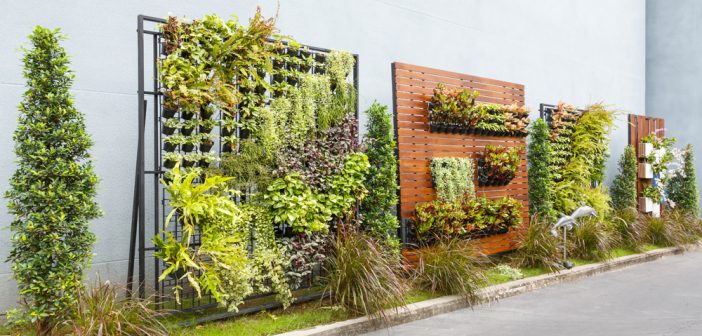Hanging gardens are taking over backyards and front lawns in cities everywhere. Whether it’s the unexpectedness of plants draped vertically or the sheer beauty of curtains of greenery, having your own hanging wall of plants is a great way to spice up the look of your home and garden.
Installing a vertical garden in your home isn’t hard to do. Many vertical gardens start with the use of a planter. A planter will allow you to stack attend plants in a row or on a wall. These planters allow the plants to grow from a stable place while allowing you to style them in whatever direction you like. If you would like to use another type of container, many homeowners have turned to pockets made of fabric like canvas or felt. these allow the plants to grow in a soft container that can be inserted into anything from fencing and mesh to wooden pallets.
The great thing about a vertical garden is that it can grow literally anywhere. Whether you prefer to have your hanging garden inside or outside– this look is a great way to add spice to any home or backyard. However, the placement of your plants will also determine the type of plants that you use in your hanging garden. If you happen to install your hanging garden in a place with little sunlight, it is best to use plants that can survive in shadier areas. Contrarily, if your plants need a lot of water, it is a good idea to put your vertical garden where they are most likely to receive the most precipitation.
Choosing the Plants
Once the placement is considered, it is important for you to carefully consider your plants. Some plants may be better suited in your vertical garden, depending on what you would like the shape of your hanging garden to look like. If you would prefer having a hanging garden that provides more shade, consider using plants like ferns, palms, or bamboo. If want to make the most of your garden, plant herbs and vegetables. Some people enjoy a hanging garden filled with flowers or grass; it all depends on your ideal aesthetic.
Avoid Varying the Plants Too Much
When curating your hanging garden; try to keep the variation to a minimum when it comes to the habitat of your plants. That means that you should avoid mixing plants that require different levels of care. If one plant needs more sun than another but the garden itself is placed in a shady area, this means that that particular plant is already going to be at a disadvantage.
Go with the Basics
Don’t skimp on the gardening basics simply because you’re creating something new. Essentials like potting soil are a must for vertical gardens, no matter what type of plants you are using. The soil will allow the plant to retain as much water as possible, ensuring it is properly moisturized at all times. Plants that need less water should be planted towards the top of the vertical garden, while plants that need more water should be towards the bottom.
Prepare Properly
A vertical garden doesn’t happen by accident. In order to grow the best looking hanging garden, you’ll need to make every effort to properly prepare before actually installing the vertical garden. That means that you will need to grow your plants in a horizontal direction before actually putting the garden together. This preparation period will allow the roots to develop and help keep the soil in place. Planting the garden vertically from the start will force it to compete with the gravitational pull, ultimately preventing the plants’ roots from properly being secured in the soil.
Consider Using Drip Irrigation
A drip irrigation system will allow you to effectively water your vertical garden. With a system like this, your garden will be irrigated with a method that allows for the water to trickle down throughout the wall with the use of hoses or simply gravity itself. The most challenging aspect of watering a vertical garden is making sure the water is evenly distributed. If you would rather attempt to water the garden by hand, consider using a hose with a wide spraying nozzle or a squirt bottle.
Have Extra Plants Handy
Despite your best efforts; some of your plants may not make it. Have extra lush, green plants on hand to keep your vertical garden looking as healthy as possible at all times.
Be sure to keep these tips and tricks in mind as you work on creating your own hanging garden. Whichever plants you choose to use for your hanging garden, be sure to keep them happy and healthy.









